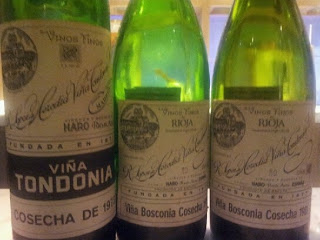12 Jul 2013: We've often heard about the allure of old Riojas and we finally found the proof in the drinking! A few wine lovers got together for an old Rioja evening - the definition of old was 1982 or older. Naturally they all came from the old school bodegas, including CVNE, López de Heredia, Marques de Murrieta and Marques de Riscal - the only one missing was La Rioja Alta. Everyone very generously contributed some prized old Rioja bottles.... Despite the minimal coordination amongst ourselves, we were able to organise the wines of the evening into 4 flights.
We started with a 1981 Viña Tondonia Blanco Gran Reserva. Golden amber in colour. There were notes of honey, toasted almonds, liquorice and orange peel on the nose, with a lanolin note on the waxy mouthfeel. Finishes long. This made a wonderful accompaniment to the iberico ham!
First flight of reds was a CVNE Viña Real flight. CVNE was founded in Haro in 1879 and the family-owned company consists of 3 wineries: Cune, Viña Real and Viñedos del Contino. The Viña Real winery is located on top of the Cerro de la Mesa, in Rioja Alavesa. The vineyards are located near the old Camino Real, hence the name Vina Real. We tasted 1954 Reserva Especial, 1962 Reserva Especial, 1970 Gran Reserva and 1973 Gran Reserva. The Gran Reserva is largely Tempranillo, with a small percentage of Graciano.
1973 Viña Real Gran Reserva: A complex bouquet of caramel, nutty, with mushroom and savoury notes. Silky texture. Still retaining good level of acidity. There's an almost sweet sensation on the finish. This wine grew on me, with time in the glass.
1970 Viña Real Gran Reserva: Earthy, tobacco and some violet notes. More linear in style, a little firmness in the structure, with a dry finish.
1962 Viña Real Reserva Especial: Tertiary notes of leather, animal, coffee and savoury notes dominated the nose, with just a hint of soya sauce. Quite restrained on the palate. Would it benefit from more time?
1954 Viña Real Reserva Especial: This was the best wine in this flight, I thought. A medium ruby colour, turning garnet at the rim. Lovely notes of violet, plum with some earthy notes. Still showing vibrant acidity, a harmonious structure, vigour and freshness. Finishes long. A wine with such old world charm, timeless elegance and harmony.
Next flight was 3 wines from López de Heredia Viña Tondonia. Don Rafael López de Heredia y Landeta, inspired by the French love for wine, and the wonderful terroir of Rioja Alta, began construction of the bodega in 1877 in Haro. The Tondonia vineyard enjoys a remarkable mesoclimate, by its proximity to the River Ebro and covers 170 hectares. The soil is alluvial clay, with a high proportion of limestone. We had 3 examples of the Gran Reservas: 1973, 1976 and 1981. Viña Tondonia is about 3/4 Tempranillo, with the balance made up of Garnacha, Graciano and Mazuelo, all from own vineyards.
1981 Viña Tondonia: Quite bretty....I didn't make much of this...
1976 Viña Tondonia: hot vintage. Notes of caramel, plum and leather on the nose. Lovely richness and concentration on the lush palate and finishes long and complex. Still tasting quite fresh, with an intact structure. I liked this best of this flight.
1973 Viña Tondonia: A little volatile....perhaps we thought that contributed to the elegance and freshness. Seemed to lack concentration. Collapsed rather quickly in the glass.
The third flight was 2 wines from Marqués de Murrieta...both Castill Ygays. The Marqués de Murrieta projected started in 1852 when Luciano Murrieta y García-Lemoine presented the first fine Rioja wine and exported it overseas for the first time in the region's history. The success encouraged him to purchase the Ygay Estate and build the Castillo Ygay. The estate is a single vineyard covering 300 hectares, located in the southern part of Rioja Alta, with a climate moderated by the Cantabrian Mountains. Castill Ygays are Gran Reserva wins, matured for 2.5 years in American oak barrels and 3 years in bottle. We tasted the 1942 and 1978 vintages.
1978 Castillo Ygay: A rancio and oloroso-like nose of liquorice, walnut, coffee and gamey notes. Medium body.....firm acidity. Not as elegant as the 1942, quite meaty.
1942 Castillo Ygay: More palo cortado like on the nose, with notes of coffee, chocolate and burnt match.....slowly revealing an elegant but lively palate.....and amazing depth. Very impressive. I was told this was bottled in 2005.
The last flight was not really a flight as such, but a single bottle of Marqués de Riscal Reserva. Marqués de Riscal was founded in Elciego, Rioja Alavesa in 1858 by Guillermo Hurtado de Amezaga. The Reserva wines are made from Tempranillo grapes grown in clay-limestone soils of Rioja Alavesa, with some addition of Graciano and Mazuelo grapes, usually not more than 10%. We tasted the 1954 Reserva. Sadly it was completely maderised!
We then finished with an unctuous and lusciously rich Alvear Pedro Ximenez de Solera 1927, Montilla-Moriles, packed with 400 grams of sugar in every litre. Like a pruney nectar with a tangy balance, it glided slowly down the throat.....delivering amazing complexity and balance. Long long finish. This was a stunning PX....that deserved a lot of attention!
Our dinner took place at Quemo, where the chef produced an excellent array of dishes...particular recommendations were smoked eggplant, egg with prawn and chorizo, paella (we had both - squid ink and quail's leg) and roast whole baby lamb and iberico pork! While the ambiance was great, the glassware and wine service could do with some improvement.....but perhaps it's not a venue meant for complicated wine dinners. I would like to go back to Quemo for a more casual dinner, so that I can relax and just enjoy the food!




No comments:
Post a Comment